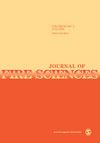林地-城市界面火灾中间距对燃烧和阴燃火焰的影响
IF 1.9
4区 工程技术
Q2 ENGINEERING, MULTIDISCIPLINARY
引用次数: 2
摘要
火牌(余烬)袭击已被证明是野火蔓延到荒地-城市界面社区的关键机制之一。在火球落在基底材料上后,材料的点火倾向不仅取决于属性(例如形状、大小和数量),还取决于火球的分布。为了帮助描述这一过程,本研究旨在研究间隙间距对一组木质样品燃烧行为的影响。实验使用九个木制立方体进行,每侧19毫米。这些样品以3×3正方形的图案排列在吊线上,并由热线圈从底面点燃。样品之间的间隙在每次测试中都有所不同(范围从0到30mm)。点火后,让样品燃烧至完全。燃烧过程用摄像机记录下来。在燃烧和阴燃过程中监测样品的质量损失和温度。结果表明,火焰高度和样品质量损失率与间隙间距具有非单调依赖关系。当间隙间距减小时,火焰高度和质量损失率首先增加,这是由于从相邻火焰向每个样品输入的热量增加。当s≤10 mm时,观察到单个样本的火焰合并为一个大火。随着s的进一步降低,火焰底部的空气夹带减少,火焰中心的火焰提升距离增加,导致火焰高度增加,对固体样品的火焰热反馈减少,质量损失率降低。质量损失率的降低最终也导致火焰高度的降低。气体火焰高度与固体燃烧速率相关。相关性通常遵循先前连续火源的经验方程。对于阴燃燃烧,与单个燃烧样品相比,由于相邻燃烧样品之间的热相互作用,阴燃温度和持续时间显著增加。为了帮助解释燃烧实验的结果,还在空气和氮气中进行热重分析,导致加热速率在10至100K/min范围内。本文章由计算机程序翻译,如有差异,请以英文原文为准。
Effects of spacing on flaming and smoldering firebrands in wildland–urban interface fires
Firebrand (ember) attack has been shown to be one of the key mechanisms of wildfire spread into wildland–urban interface communities. After the firebrands land on a substrate material, the ignition propensity of the material depends on not only the attributes (e.g. shape, size, and numbers) but also the distribution of the firebrands. To help characterize this process, this study aims to investigate the effects of gap spacing on the burning behaviors of a group of wooden samples. Experiments are conducted using nine wooden cubes, 19 mm on each side. These samples are arranged in a 3 × 3 square pattern on suspension wires and are ignited by hot coils from the bottom surface. The gap spacing (s) between the samples varies in each test (ranging from 0 to 30 mm). After ignition, the samples are left to burn to completion. The burning process is recorded using video cameras. Sample mass loss and temperatures are monitored during the flaming and smoldering processes. The results show that the flame height and the sample mass loss rate have non-monotonic dependencies on the gap spacing. When the gap spacing reduces, the flame height and the mass loss rate first increase due to enhanced heat input from the adjacent flames to each sample. When s ≤ 10 mm, flames from individual samples are observed to merge into a single large fire. As s further decreases, the air entrainment at the flame bottom decreases and the flame lift-off distance at the flame center increases, resulting in an increased flame height, decreased flame heat feedback to the solid samples, and a decreased mass loss rate. The decreased mass loss rate eventually leads to a decrease in the flame height as well. The gaseous flame height is correlated to the solid burning rate. The correlation generally follows previous empirical equations for continuous fire sources. For the smoldering combustion, compared to a single burning sample, the smoldering temperature and duration significantly increase due to the thermal interactions between adjacent burning samples. To help interpret the results of the burning experiments, thermogravimetric analysis is also performed in air and nitrogen, resulting in heating rates ranging from 10 to 100 K/min.
求助全文
通过发布文献求助,成功后即可免费获取论文全文。
去求助
来源期刊

Journal of Fire Sciences
工程技术-材料科学:综合
CiteScore
4.00
自引率
0.00%
发文量
14
审稿时长
2.5 months
期刊介绍:
The Journal of Fire Sciences is a leading journal for the reporting of significant fundamental and applied research that brings understanding of fire chemistry and fire physics to fire safety. Its content is aimed toward the prevention and mitigation of the adverse effects of fires involving combustible materials, as well as development of new tools to better address fire safety needs. The Journal of Fire Sciences covers experimental or theoretical studies of fire initiation and growth, flame retardant chemistry, fire physics relative to material behavior, fire containment, fire threat to people and the environment and fire safety engineering. This journal is a member of the Committee on Publication Ethics (COPE).
 求助内容:
求助内容: 应助结果提醒方式:
应助结果提醒方式:


